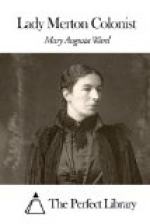What was going to happen? Mrs. Gaddesden was conscious in her own mind of a strained hush of expectation. But she had never ventured to say a word to Elizabeth. In half an hour—or less—he would be here. A motor had been sent to meet the express train at the country town fifteen miles off. Mrs. Gaddesden looked round her in the warm dusk, as though trying to forecast how Martindale and its inmates would look to the new-comer. She saw a room of medium size, which from the end of the sixteenth century had been known as the Red Drawing Room—a room panelled in stamped Cordovan leather, and filled with rare and beautiful things; with ebony cabinets, and fine lacquer; with the rarest of oriental carpets, with carved chairs, and luxurious sofas. Set here and there, sparingly, among the shadows, as though in scorn of any vulgar profusion, the eye caught the gleam of old silver, or rock crystal, or agate; bibelots collected a hundred and fifty years ago by a Gaddesden of taste, and still in their original places. Overhead, the uneven stucco ceiling showed a pattern of Tudor roses; opposite to Mrs. Gaddesden the wall was divided between a round mirror, in whose depths she saw herself reflected and a fine Holbein portrait of a man, in a flat velvet hat on a green background. Over the carved mantelpiece with its date of 1586, there reigned a Romney portrait—one of the most famous in existence—of a young girl in black. Elizabeth Merton bore a curious resemblance to it. Chrysanthemums, white, yellow and purple, gleamed amid the richness of the room; while the light of the solitary lamp beside which Mrs. Gaddesden had been sitting with her embroidery, blended with the orange glow from outside now streaming in through the unshuttered windows, to deepen a colour effect of extraordinary beauty, produced partly by time, partly by the conscious effort of a dozen generations.
And from the window, under the winter sunset, Mrs. Gaddesden could see, at right angles to her on either side, the northern and southern wings of the great house; the sloping lawns; the river winding through the park; the ivy-grown church among the trees; the distant woods and plantations; the purple outlines of the fells. Just as in the room within, so the scene without was fused into a perfect harmony and keeping by the mellowing light. There was in it not a jarring note, a ragged line—age and dignity, wealth and undisputed place: Martindale expressed them all. The Gaddesdens had twice refused a peerage; and with contempt. In their belief, to be Mr. Gaddesden of Martindale was enough; a dukedom could not have bettered it. And the whole country-side in which they had been rooted for centuries agreed with them. There had even been a certain disapproval of the financial successes of Philip Gaddesden’s father. It was true that the Gaddesden rents had gone down. But the country, however commercialised itself, looked with jealousy on any intrusion of “commercialism” into the guarded and venerable precincts of Martindale.




